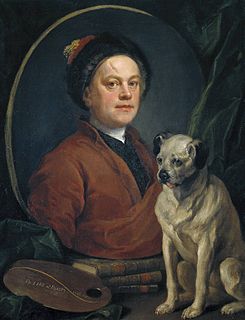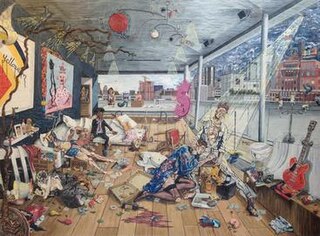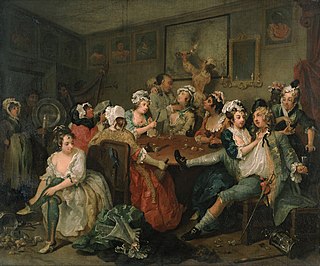See also
| This disambiguation page lists articles associated with the title Rake's Progress. If an internal link led you here, you may wish to change the link to point directly to the intended article. |
A Rake's Progress is a series of eight paintings by British artist William Hogarth.
Rake's Progress may also refer to:
| This disambiguation page lists articles associated with the title Rake's Progress. If an internal link led you here, you may wish to change the link to point directly to the intended article. |
Spring(s) may refer to:

William Hogarth was an English painter, printmaker, pictorial satirist, social critic, and editorial cartoonist. His work ranges from realistic portraiture to comic strip-like series of pictures called "modern moral subjects", and he is perhaps best known for his series A Harlot's Progress, A Rake's Progress and Marriage A-la-Mode. Knowledge of his work is so pervasive that satirical political illustrations in this style are often referred to as "Hogarthian".

Dame Ninette de Valois was an Irish-born British dancer, teacher, choreographer, and director of classical ballet. Most notably, she danced professionally with Serge Diaghilev's Ballets Russes, later establishing the Royal Ballet, one of the foremost ballet companies of the 20th century and one of the leading ballet companies in the world. She also established the Royal Ballet School and the touring company which became the Birmingham Royal Ballet. She is widely regarded as one of the most influential figures in the history of ballet and as the "godmother" of English and Irish ballet.
The Parable of the Prodigal Son is a parable of Jesus from the Bible.
The Four Seasons, originally referring to the traditional seasons of spring, summer, autumn and winter, may refer to:
A dream is an experience during sleep. It may also refer to a wish, as in a motivating personal ambition or goal, a romantic prospect, or a vision of future change.
5 is a number, numeral, and glyph.
A Rake's Progress is a series of eight paintings by 18th-century English artist William Hogarth. The canvases were produced in 1732–34, then engraved in 1734 and published in print form in 1735. The series shows the decline and fall of Tom Rakewell, the spendthrift son and heir of a rich merchant, who comes to London, wastes all his money on luxurious living, prostitution and gambling, and as a consequence is imprisoned in the Fleet Prison and ultimately Bethlem Hospital (Bedlam). The original paintings are in the collection of Sir John Soane's Museum in London, where they are normally on display for a short period each day.
Irma is a female given name.
The seven deadly sins is a classification of vices used in Christian teachings.

The Rake's Progress is a 1945 British comedy-drama film. In the United States, the title was changed to Notorious Gentleman. The film caused controversy with U.S. censors of the time, who trimmed scenes for what was considered graphic amoral and sexual content.
British ballet is most recognised for two leading methods, those of the Royal Ballet School and the Royal Academy of Dance. The identifying characteristic of British ballet is the focus on clean, precise technique and purity of line that is free of exaggeration and mannerisms. The training of dancers in Britain is noted for its slow progression, with a great deal of attention paid to basic technique. British ballet methods operate on the principle that establishing correct technique and strength slowly makes it much easier for the student to adapt to more difficult vocabulary and techniques later on.

Henry Hudson is a British artist who lives and works in London. He is best known for his use of Plasticine as his artistic medium in the creation of textured ‘paintings’. Hudson's most notable exhibition to date was The Rise and Fall of Young Sen – The Contemporary Artist’s Progress, which was shown at Sotheby's SI2 Gallery, London in May 2015. The exhibition consisted of ten large scale Plasticine paintings, depicting a contemporary version of William Hogarth's ARake's Progress. According to the New York Times, all ten paintings were sold prior to the show opening.
Doom may refer to:
Gavin Gordon was a Scottish bass singer, actor and composer, best known for his 1935 Hogarthian ballet The Rake's Progress.
The Rake's Progress is a short 1935 ballet based on the drawings of William Hogarth, with music by Gavin Gordon (1901-1970), choreography by Ninette de Valois, and set design by Rex Whistler.
Ondine is a variation of undine, the category of elemental beings associated with water

William Chappell was a British dancer, ballet designer and director. He is most noted for his designs for more than 40 ballets or revues, including many of the early works of Sir Frederick Ashton and Dame Ninette de Valois.

David Wall, CBE was an English ballet dancer, who, at the age of 21, became the youngest male Principal in the history of The Royal Ballet.

Tavern Scene or The Orgy is a work by William Hogarth from 1735, the third picture from the series A Rake's Progress.